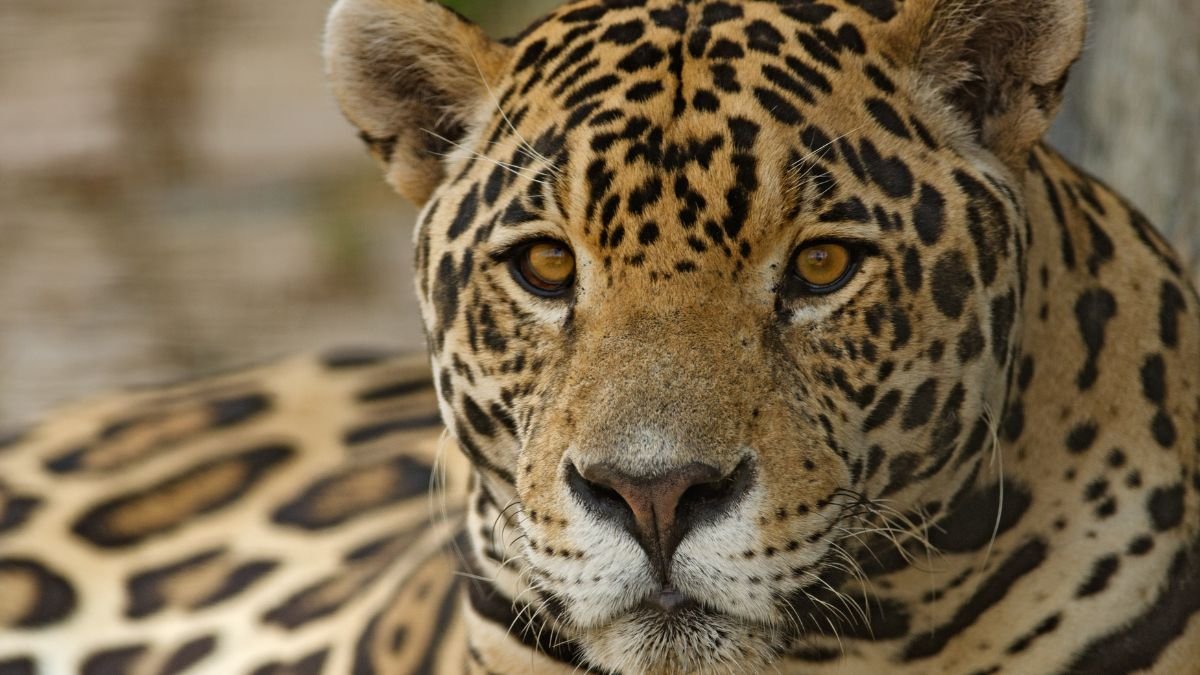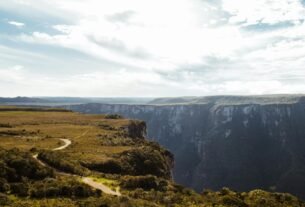Introduction
Have you ever wondered where you can experience South America’s wildlife in its purest form? The Pantanal, the world’s largest tropical wetland, offers an unparalleled adventure that is truly unique. Spanning over 230,000 km², this vast region is a treasure trove of biodiversity, hosting over 1,000 bird species, 300 mammals, and 500 reptiles, making it one of the most diverse ecosystems on the planet.
The Pantanal is not only significant for its diverse array of species but also for its crucial role in maintaining ecological balance, as it serves as a vital habitat for both migratory and resident wildlife. Here, you can find iconic animals such as the elusive jaguar, which prowls the riverbanks, as well as playful giant otters that inhabit the waterways.
Additionally, the vibrant colors of the hyacinth macaw add a stunning visual to the landscape. This region’s unique seasonal flooding creates a dynamic environment that supports a rich array of flora and fauna, providing endless opportunities to observe the remarkable animals in Pantanal for exploration and discovery.
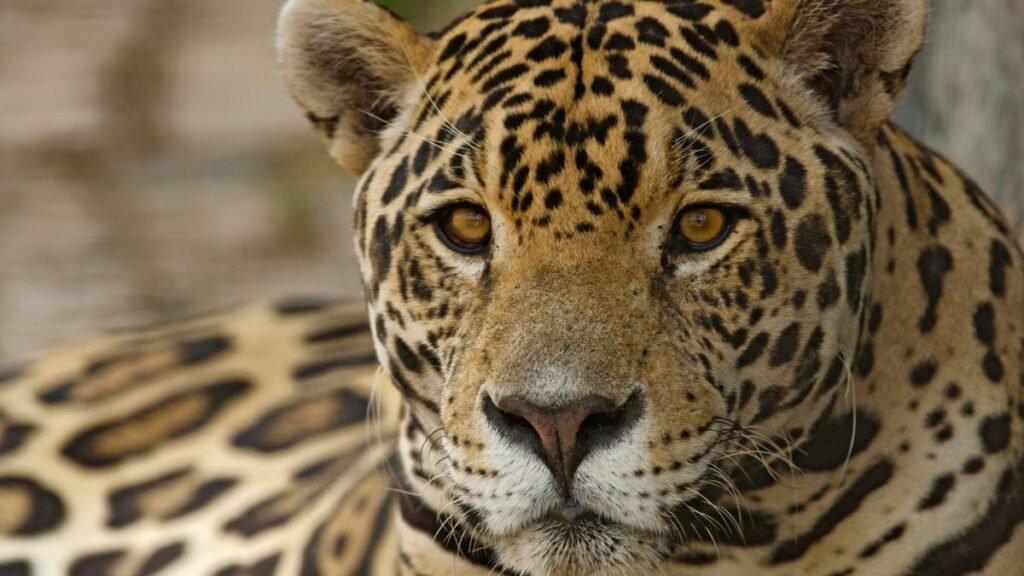
Unlike the dense Amazon, the Pantanal’s open landscapes make it easier to spot its inhabitants. From majestic jaguars to vibrant hyacinth macaws, the area is a year-round destination. The dry season, from July to October, is particularly ideal for sightings. Whether you’re a nature enthusiast or a casual traveler, the Pantanal promises unforgettable encounters — and if you’re exploring Central Brazil, a visit to the breathtaking Chapada dos Veadeiros offers a perfect complement, with its waterfalls, canyons, and unique biodiversity.”
Key Takeaways
- The Pantanal is the largest tropical wetland in the world.
- It is home to over 1,000 bird species and 300 mammals.
- The region offers easier wildlife spotting compared to the Amazon.
- The best time to visit for optimal sightings is from July to October.
- Iconic species include jaguars, giant otters, and hyacinth macaws.
Animals in Pantanal: A Haven for Wildlife
South America’s Pantanal is a living mosaic of ecosystems, teeming with life at every turn. This vast region, often overshadowed by the Amazon, is a hidden gem for wildlife enthusiasts. Its open landscapes and seasonal transformations make it a hotspot for biodiversity.
Why the Pantanal is a Must-Visit for Wildlife Enthusiasts
The Pantanal is home to over 156 mammal species, including the elusive maned wolf and the lowland tapir. Unlike dense forests, its open terrain allows for easier sightings. During the dry season, the region transforms into a network of “animal highways,” where creatures gather around shrinking water sources.
This unique phenomenon creates unparalleled opportunities for observation. The Transpantaneira road system acts as a prime wildlife corridor, offering visitors a front-row seat to nature’s drama.
The Unique Ecosystem of the Pantanal
The Pantanal’s ecosystem is a blend of the Amazon, Cerrado, and Chaco regions. Seasonal flooding enriches the soil, creating nutrient-rich habitats that support over 650 bird species. This biodiversity rivals that of African savannahs, with visible congregations of wildlife.
One of the most fascinating aspects is the interaction between species. Jaguars and giant otters, for instance, share the same waterways, showcasing the delicate balance of this ecosystem. Conservation efforts have also seen success, with the recovery of the giant otter population being a notable achievement.
| Region | Biodiversity Highlights | Unique Features |
|---|---|---|
| Pantanal | 156 mammal species, 650 bird species | Seasonal flooding, animal highways |
| Amazon | 400 mammal species, 1,300 bird species | Dense forests, high canopy diversity |
| African Savannah | Large mammal congregations | Open plains, migration routes |
How to Spot the Elusive Jaguar
Spotting a jaguar in the wild is a dream for many nature lovers. The Pantanal offers one of the best chances to see Pantanal’s most iconic predator. With a 95% success rate along the Cuiabá River, this region is a hotspot for jaguar sightings.
Best Times and Locations for Jaguar Sightings
The dry season, from July to October, is ideal for spotting jaguars. During this time, the shrinking water sources along the river forced wildlife to gather in specific areas. Porto Jofre, a prime base for specialized boat safaris, is the go-to location for these encounters. For those looking to expand their journey through Central Brazil, the nearby Chapada dos Guimarães offers dramatic cliffs, waterfalls, and panoramic views that add a stunning contrast to the Pantanal’s wetlands.
Early morning and late afternoon patrols offer the best viewing windows. Guides use radio communication to track recent sightings, increasing your chances of a successful encounter.
Tips for a Successful Jaguar Safari
To maximize your odds, plan a minimum 3-day stay at Porto Jofre lodges. This allows ample time to explore the area and increases your chances of spotting a jaguar. When on a boat, position it carefully to avoid disturbing the animal’s natural behavior.
Look for identifying features, such as rosette patterns and territorial scratch marks. For photography, use a lens of 400 mm or longer from a stable watercraft to capture stunning images. A knowledgeable guide can also help you spot other wildlife, such as caimans, during your safari.
Discover the Capybara: The World’s Largest Rodent
Meet the capybara, a South American giant that thrives in wetland habitats. Weighing up to 50kg, these gentle creatures are the largest rodents on Earth. Their unique adaptations, like webbed feet and ever-growing teeth, make them perfectly suited for life near water.
Understanding Capybara Behavior
Capybaras are highly social animals, living in groups of 10 to 20 members. These family units are led by an alpha male, who maintains order and protects the group. They are herbivores, feeding on grasses and vegetation, and play a crucial role as ecosystem engineers by shaping their environment through grazing.
One of their most fascinating behaviors is creating communal mud wallows near oxbow lakes. These wallows serve as gathering spots and help regulate their body temperature. To learn more about capybara behavior, explore their unique habits and adaptations.
Where to Find Capybaras in the Pantanal
The Northern Pantanal, particularly Fazenda San Francisco, is a prime location for spotting capybaras. During sunset, groups often gather at the water’s edge, offering a perfect opportunity for observation. Their presence is a testament to the region’s rich biodiversity and the delicate balance of its ecosystem.
The Giant Otter: A Master of the Rivers
Few creatures embody the spirit of the wetlands like the giant otter. As the world’s largest otter species, it reaches up to 1.8 meters in length and boasts unique throat markings that act like fingerprints. These markings help researchers identify individuals in the wild.
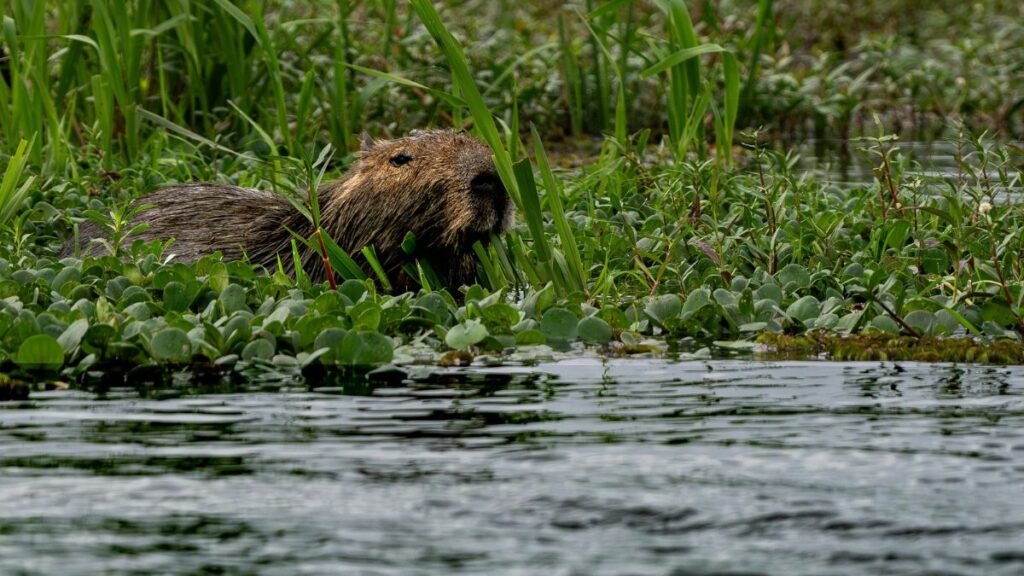
Giant otters are skilled hunters, relying on coordinated tactics to catch their prey. They consume 3-4 kilograms of fish daily, often working together in family groups. Their vocal communication system comprises 22 distinct sounds, enabling them to coordinate hunts and alert one another to potential dangers.
Characteristics of the Giant Otter
These otters are highly social, living in tight-knit family units. Their diet consists mainly of fish, but they also hunt small reptiles and crustaceans. Unlike solitary predators like jaguars, giant otters rely on teamwork to secure their meals.
Their populations are rebounding near the Pixaim River tributaries, thanks to conservation efforts. This recovery highlights the importance of protecting their habitats.
How to Observe Giant Otters in Their Natural Habitat
The best time to observe giant otters is during their morning feeding rituals, between 7:00 and 9:00 AM. Quiet tributaries of the Cuiabá River are ideal spots for sightings. Maintain a distance of at least 30 meters to avoid disturbing their natural behavior.
For a memorable experience, join a guided tour that emphasizes ethical wildlife observation. These tours often provide insights into the otters’ hunting strategies and their role in the ecosystem.
Anacondas: Myths and Realities
The anaconda, one of the most misunderstood reptiles, holds a unique place in the Pantanal ecosystem. Often portrayed as aggressive predators in movies, these creatures are far more complex and less dangerous than Hollywood suggests. Understanding their behavior and habitat can transform fear into fascination.
Different Species of Anacondas in the Pantanal
The Pantanal is home to two primary species: the green anaconda and the yellow anaconda. Green anacondas are the largest, often exceeding 200kg, while yellow anacondas average around 40kg. Their distinct appearances make identification easier. Green anacondas have an olive hue, while yellow anacondas feature patterned skin.
These reptiles thrive near water sources, such as rivers and oxbow lakes. They are constrictors, using their immense strength to subdue prey. Contrary to popular belief, they only attack when threatened and feed monthly, relying on their slow metabolism.
| Species | Average Weight | Habitat |
|---|---|---|
| Green Anaconda | Exceeds 200kg | Rivers, lakes |
| Yellow Anaconda | ~40kg | Marshes, streams |
Safety Tips for Encountering Anacondas
If you encounter an anaconda, remain calm and avoid sudden movements. These creatures are not naturally aggressive toward humans. A guide can provide valuable insights and ensure safe observations during night walks near the Transpantaneira road bridges, where they are commonly spotted.
For accidental proximity, slowly back away without turning your back. Remember, anacondas are primarily interested in their natural prey, not humans. To learn more about responsible wildlife encounters, visit this guide.
Piranha Fishing: A Unique Pantanal Experience
Fishing for piranhas in the Pantanal is an experience that blends thrill and culture. This activity not only connects you with the region’s aquatic life but also offers a glimpse into local traditions. The red-bellied piranha, the most commonly targeted species, is a fascinating predator known for its sharp teeth and feeding frenzies.
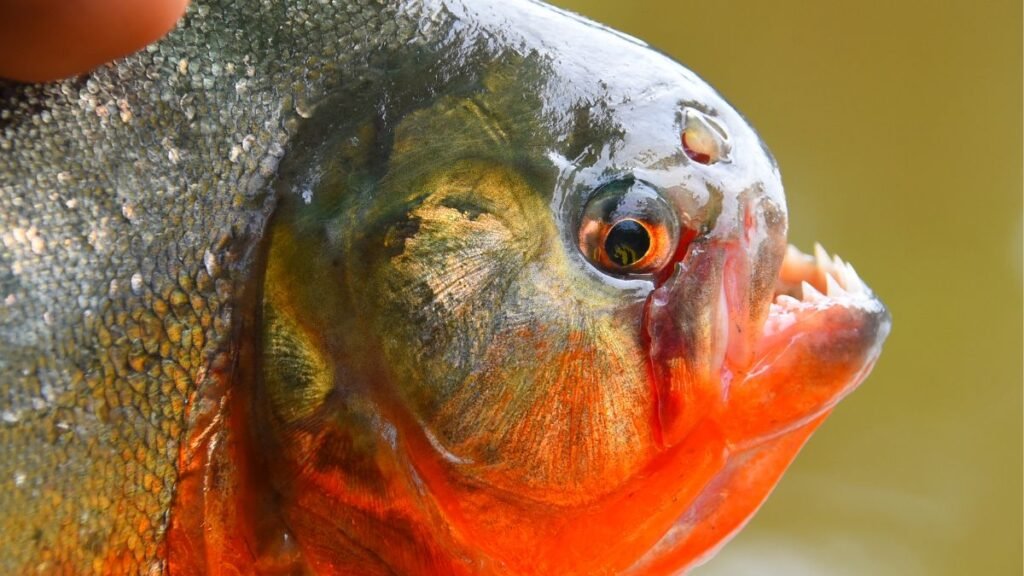
How to Safely Fish for Piranhas
To fish for piranhas, use bamboo poles equipped with 15cm steel leaders to prevent their teeth from cutting the line. Late afternoons are the best time, as piranhas are most active during feeding frenzies. Always handle them with care, using long-nose pliers to remove hooks safely.
Conservation is key. Practice catch-and-release to protect the fish population. This ensures that future visitors can enjoy the same thrilling experience while preserving the ecosystem.
Culinary Delights: Cooking Piranha
Piranha is a staple in Pantaneiro cuisine, often fried whole and served with lime and farofa. Its flavor is often compared to tilapia, but with a firmer texture. This dish holds cultural significance, reflecting the region’s connection to its waterways.
Whether you’re fishing for fun or preparing a traditional meal, piranha fishing offers a unique way to engage with the Pantanal’s rich heritage and biodiversity.
The Ocelot: A Smaller but Equally Fascinating Cat
The ocelot, a lesser-known feline, is a master of stealth and adaptation. Weighing between 29 and 40kg, this nocturnal hunter thrives in the diverse landscapes of South America. Its Aztec-derived name, meaning “field tiger,” reflects its agility and prowess.
Identifying Ocelots in the Wild
No two ocelots share the same spot pattern, making each individual unique. These patterns are key to identification and research. At Jaguar Lodge, baited observation platforms and night cameras have proven highly successful for spotting these elusive mammals.
Their hunting techniques, although similar to those of larger cats like jaguars, are adapted to their smaller size. Ocelots mark their territory using scent posts, which helps them maintain dominance in the wild.
Conservation Status of the Ocelot
Reforestation efforts in Mato Grosso do Sul have provided hope for the ocelot’s future. These initiatives aim to restore their natural habitat, ensuring their survival. Conservationists emphasize the importance of protecting these animals to maintain ecological balance.
By understanding their behavior and habitat, we can contribute to their preservation. The ocelot’s role in the ecosystem is a reminder of the interconnectedness of all species.
Caimans: The Reptilian Guardians of the Pantanal
With a population density of 10 million, caimans dominate the wetlands like no other reptile. These ancient creatures are more than just predators; they are vital to the ecosystem of the Pantanal. From nutrient cycling to migration patterns, their presence profoundly shapes the region’s life.
Understanding Caiman Behavior
Caimans are masters of adaptation. During the wet season, they create “caiman highways” as they migrate across flooded plains. This movement ensures their survival and helps distribute nutrients through the consumption of carrion. Their role in nutrient cycling is critical for maintaining the health of the waterways.
One fascinating behavior is thermoregulation. Caimans often bask with their mouths open to cool down, a sight commonly seen during the dry season. At Salina do Brejão, visitors gather in large groups, creating a spectacle.
Where to Spot Caimans During Your Visit
Night spotlighting is the best way to observe caimans. Their eyes reflect light, making them easy to spot along riverbanks. This technique is safe and minimizes disturbance to their natural behavior. Contrary to myths, caimans rarely pose a threat to humans unless provoked.
Another unique sight is their symbiotic relationship with cattle egrets. These birds often perch on caimans, feeding on insects and parasites. This mutualistic interaction highlights the interconnectedness of the Pantanal’s ecosystem.
| Behavior | Significance |
|---|---|
| Thermoregulation | Helps regulate body temperature |
| Nutrient Cycling | Maintains ecosystem health |
| Symbiosis with Cattle Egrets | Mutualistic relationship |
Marsh Deer: The Largest Deer in South America
The marsh deer, a majestic symbol of South America’s wetlands, stands tall in both stature and ecological importance. Standing 1.2 meters at the shoulder, this deer is the largest of its kind on the continent. Its splayed hooves and water-repellent fur are perfect adaptations for life in aquatic environments.
Habitat and Behavior of Marsh Deer
Marsh deer thrive in areas rich in vegetation, such as flooded grasslands and riverbanks. They are primarily solitary but can form small groups during the rutting season. Their diet consists of aquatic plants, which they graze on while wading through shallow waters.
One of their most fascinating behaviors is the seasonal shedding of antlers, which occurs in June. This cycle is closely tied to their reproductive patterns. Conservation breeding programs have been initiated to combat their 80% population decline since 1950, primarily due to habitat loss.
Best Spots for Marsh Deer Sightings
For the best chance to observe these animals, head to Fazenda Santa Tereza in the southern Pantanal. Dawn is the ideal time, especially during the rutting season when males are more active. Their remaining strongholds are concentrated in this region, making it a prime location for sightings.
| Feature | Detail |
|---|---|
| Height | 1.2 meters at shoulder |
| Adaptations | Splayed hooves, water-repellent fur |
| Diet | Aquatic plants |
| Conservation Status | 80% population decline since 1950 |
“The marsh deer is not just a species; it’s a symbol of the delicate balance in our wetlands.”
Birdwatching in the Pantanal: A Feathered Paradise
The Pantanal is a haven for bird enthusiasts, offering a diverse array of species to discover. With over 650 birds recorded, this region represents 53% of Brazil’s avifauna. From the vibrant hyacinth macaw to the towering jabiru stork, every corner of the Pantanal is alive with avian wonders.
Prime locations like Porto Jofre and Pousada Piuval are hotspots for sightings. These areas provide access to microhabitats ranging from river edges to forest canopies. Whether you’re a seasoned birder or a beginner, the Pantanal promises unforgettable encounters.
Iconic Birds to Look Out For
The hyacinth macaw, with its striking blue plumage, is a must-see. These parrots nest in manduvi trees, making these locations ideal for observation. The jabiru stork, known for its massive 2-meter-wide nests, is another highlight. Its distinctive black-and-white feathers and red neck make it easy to spot.
Other notable species include the toco toucan, the roseate spoonbill, and the kingfisher. Each bird has unique behaviors and calls, adding to the richness of the experience. Learning to identify their calls can enhance your birdwatching adventure.
Tips for Successful Birdwatching
To make the most of your trip, invest in a pair of 10×42 binoculars. These provide the clarity needed to spot birds from a distance. Early mornings and late afternoons are the best times for sightings, as birds are most active during these periods.
Respect ethical photography distances, especially near nesting sites. Use a telephoto lens to capture stunning images without disturbing the birds. Guided tours can also help you navigate the region and identify key species.
| Bird | Key Feature | Best Location |
|---|---|---|
| Hyacinth Macaw | Blue plumage, nests in manduvi trees | Porto Jofre |
| Jabiru Stork | 2-meter-wide nests, red neck | Pousada Piuval |
| Toco Toucan | Large orange beak | River edges |
Conclusion: Your Unforgettable Pantanal Adventure
Exploring the wetlands offers a chance to witness nature’s raw beauty. With a 98% satisfaction rate for jaguar sightings and an average of 120 species spotted per visit, this region is a wildlife paradise. From vibrant birds to ancient reptiles, every moment here is a discovery.
Pack essentials like quick-dry clothing and a telephoto lens to capture the magic. The dry season, from July to October, is ideal for wildlife spotting, while the wet season showcases lush landscapes. Certified eco-lodges, accompanied by expert guides, ensure a seamless experience.
For a full immersion experience, plan a multi-day stay. This allows you to explore diverse habitats and connect with the life that thrives here. Your journey through South America’s wetlands will leave you with memories to last a lifetime. Learn more Serra do Roncador.
FAQ
Why is the Pantanal considered a wildlife haven?
The Pantanal is home to an unparalleled diversity of species, including jaguars, capybaras, giant otters, and over 650 bird species. Its vast wetlands and unique ecosystem make it a hotspot for wildlife enthusiasts.
What is the best time to spot a jaguar in the Pantanal?
The dry season, from July to October, is ideal for jaguar sightings. During this time, the big cats are often seen near rivers and water sources, hunting for prey.
Where can I find capybaras in the Pantanal?
Capybaras are commonly found near rivers, lakes, and marshy areas. They thrive in groups and are most active during the early morning or late afternoon.
How can I observe giant otters in their natural habitat?
Giant otters are often spotted in rivers and lagoons. Early morning boat tours increase your chances of witnessing these playful creatures.
Are anacondas dangerous to humans in the Pantanal?
While anacondas are large and powerful, they are generally not aggressive toward humans. It’s essential to maintain a safe distance and refrain from disturbing them in their natural habitat.
Is piranha fishing safe in the Pantanal?
Yes, piranha fishing is safe when done with a local guide. They provide the necessary equipment and ensure you follow safety protocols while enjoying this unique experience.
How can I identify an ocelot in the wild?
Ocelots are smaller than jaguars and have distinctive spotted coats. They are nocturnal, so spotting them requires patience and guided night tours.
Where are caimans most commonly seen in the Pantanal?
Caimans are abundant in rivers, lakes, and other wetland habitats. They are often seen basking on riverbanks or swimming in the water during the day.
What makes the marsh deer unique in South America?
The marsh deer is the largest deer species in South America, adapted to wetland habitats. Its long legs and reddish-brown coat make it easily recognizable.
What are some iconic birds to look for in the Pantanal?
The Pantanal is a birdwatcher’s paradise, home to species like the hyacinth macaw, jabiru stork, and toucan. Early morning is the best time for birdwatching.

